INTRODUCTION
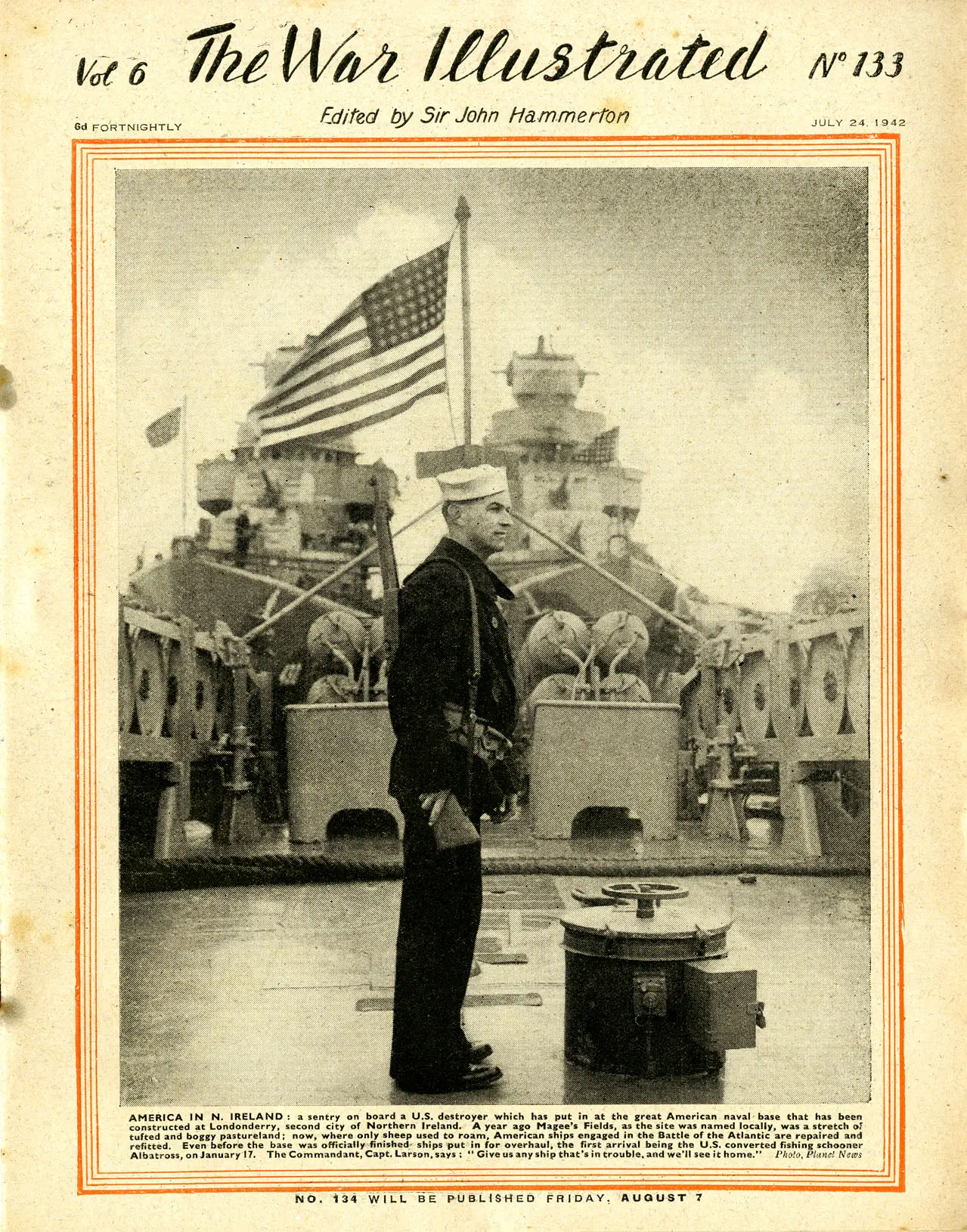
This exhibit tells the story of Operation Torch, the code-name for Allied landings in French North Africa in 1942, mainly as told in the pages of a British magazine, War Illustrated. This weekly publication used maps, reports and photographs to represent the war to a large audience. Most images in this exhibit can be clicked on to enlarge them, view additional pictures, and read transcribed text.
Torch was the first important Anglo-American operation of World War II, and the first large-scale Allied amphibious landing. The operation marked the first involvement of American forces – and Battleship Texas herself - in the war against Germany. America’s arrival was welcomed in War Illustrated as a step on the Allied road towards the liberation of Europe. However, Torch was not just a practice run for the D-Day landings. In 1942 America had only just entered the war, and the outcome was far from certain. Success in Torch would provide a victory at a critical time: cooperation was vital, but alliances can be difficult to make and even more challenging to maintain.
America, Britain, and
The World War
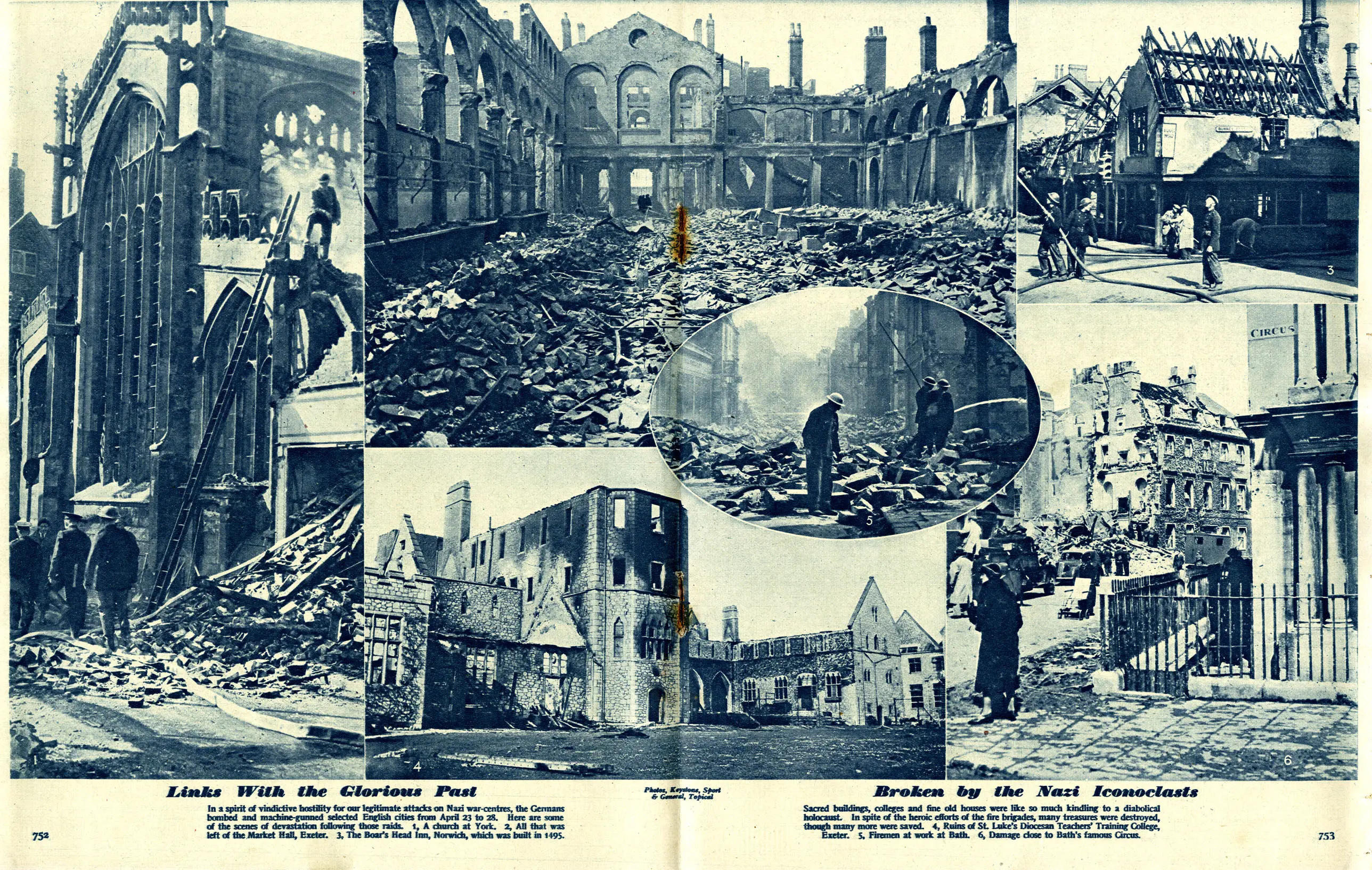
In 1942 the situation still looked doubtful for the Allies. British cities had been bombed in the ‘Blitz.’ Much of Europe had been under Nazi occupation for nearly two years. German U-boats threatened Britain’s supply lines in the Atlantic. The attack on Pearl Harbour had brought the Americans into the war. On the Eastern Front the Soviet Union’s war against the bulk of Germany’s armies was supported by convoys through the Arctic protected by American and British ships. Mass production of ships, planes, tanks and guns was the United States’ essential contribution to the Allied cause. ‘In this war’, President Roosevelt declared, ‘we are all soldiers, whether in uniforms, overalls or shirt sleeves.’
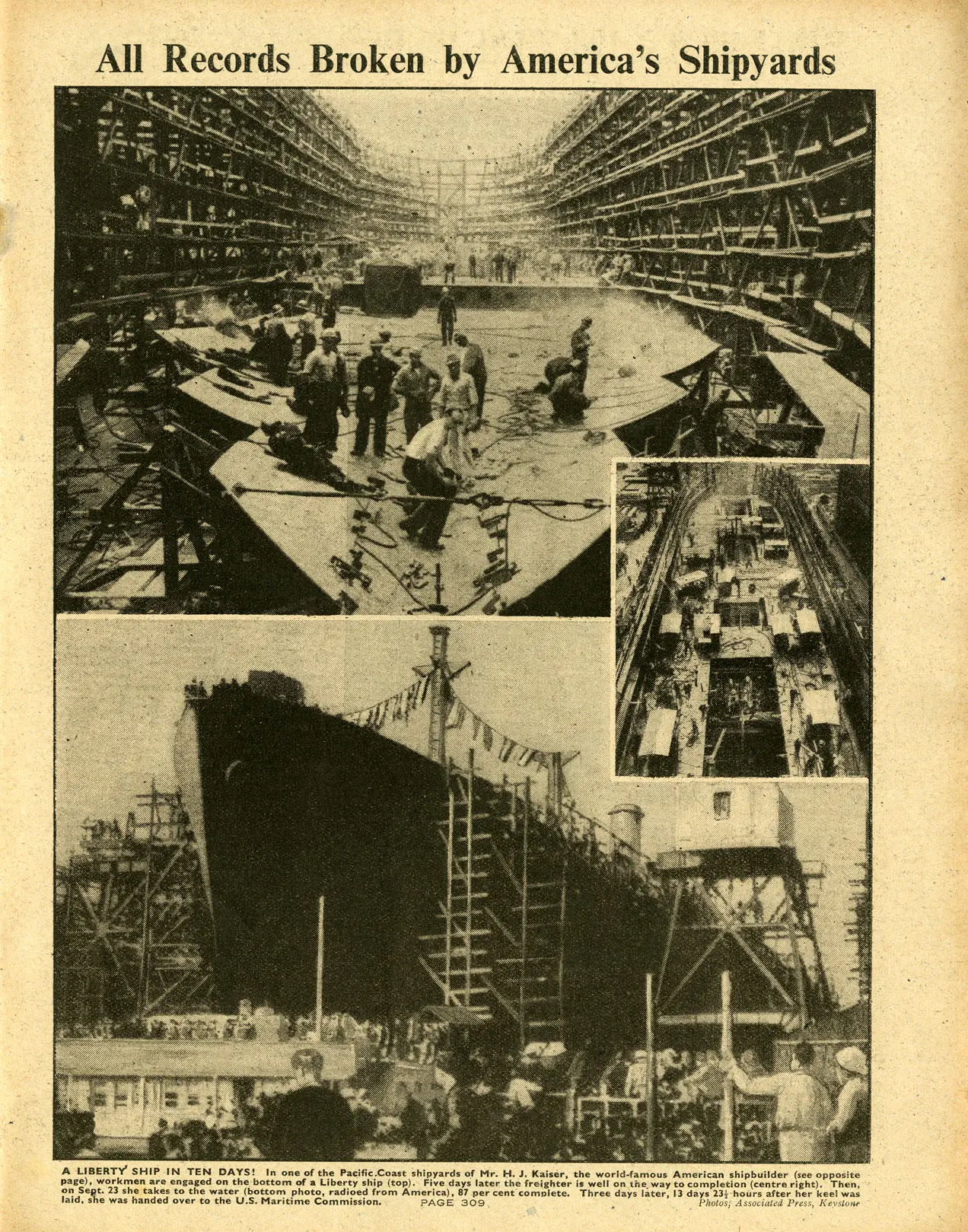
The Widening War
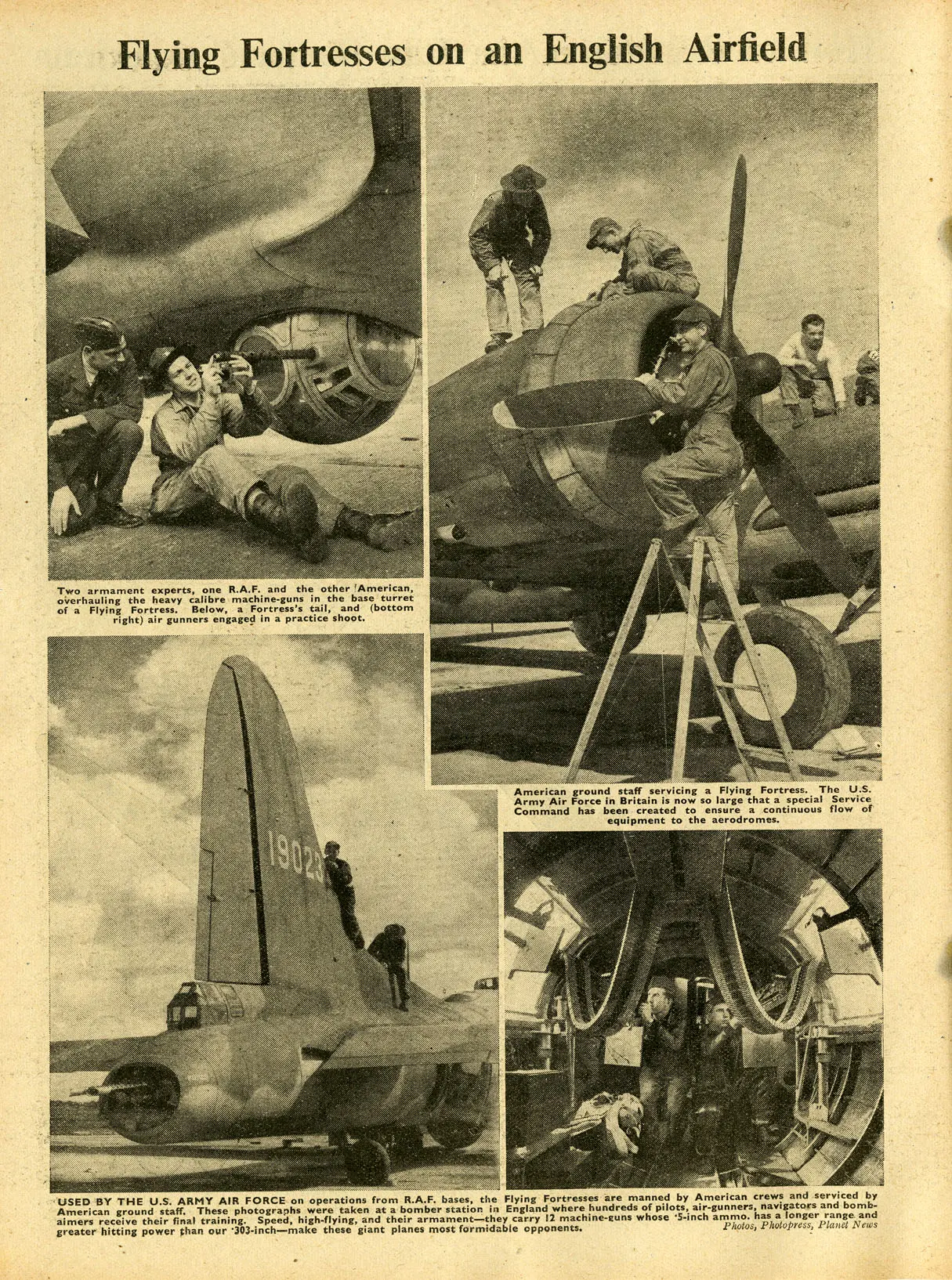
Meanwhile, American bomber crews arrived in Britain to begin their daylight air offensive against Germany. Many had not been abroad before and were given booklets to help them settle in. After the Battle of Midway, America was finally on the attack in the Pacific with the landings at Guadalcanal. Although a ‘second front’ was eagerly anticipated, the Allies would not be ready for the invasion of Europe until at least 1943. A joint operation in 1942 was necessary, for the Allies to gain experience, to do something to push back the Axis powers and above all to boost morale.
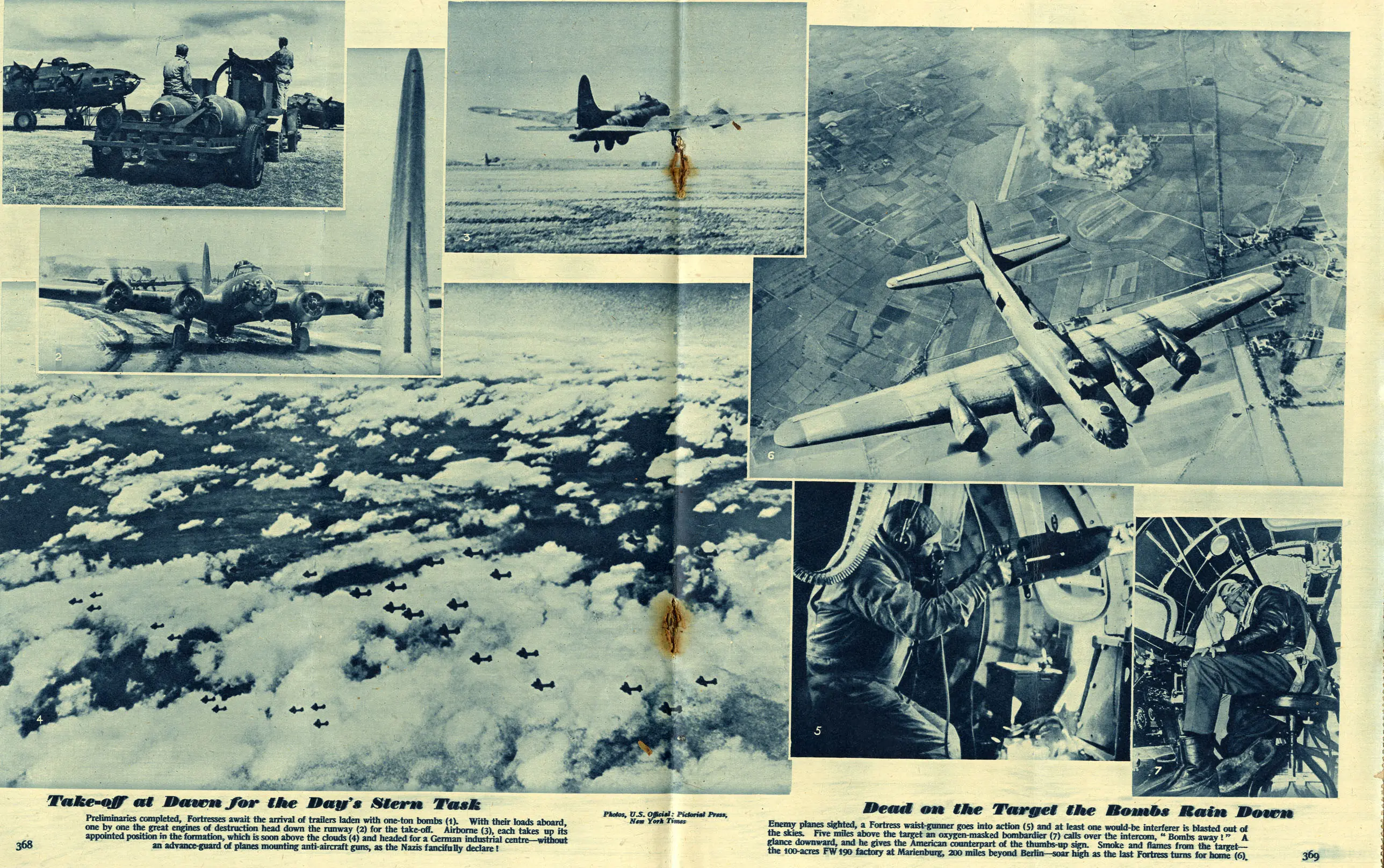

THE WAR ILLUSTRATED
Edited by Sir John Hammerton July 24, 1942
AMERICA IN N. IRELAND: a sentry on board a U.S. destroyer which has put in at the great American naval base that has been constructed at Londonderry, second city of Northern Ireland. A year ago Magee's Fields, as the site was named locally, was a stretch of tufted and boggy pastureland; now, where only sheep used to roam, American ships engaged in the Battle of the Atlantic are repaired and refitted. Even before the base was officially finished ships put in for overhaul, the first arrival being the U.S. converted fishing schooner Albatross, on January 17. The Commandant, Capt. Larson, says: "Give us any ship that's in trouble, and we'll see it home." Photo, Planet News
Citation:
Image reproduced courtesy of The University of Sheffield Library Special Collections.

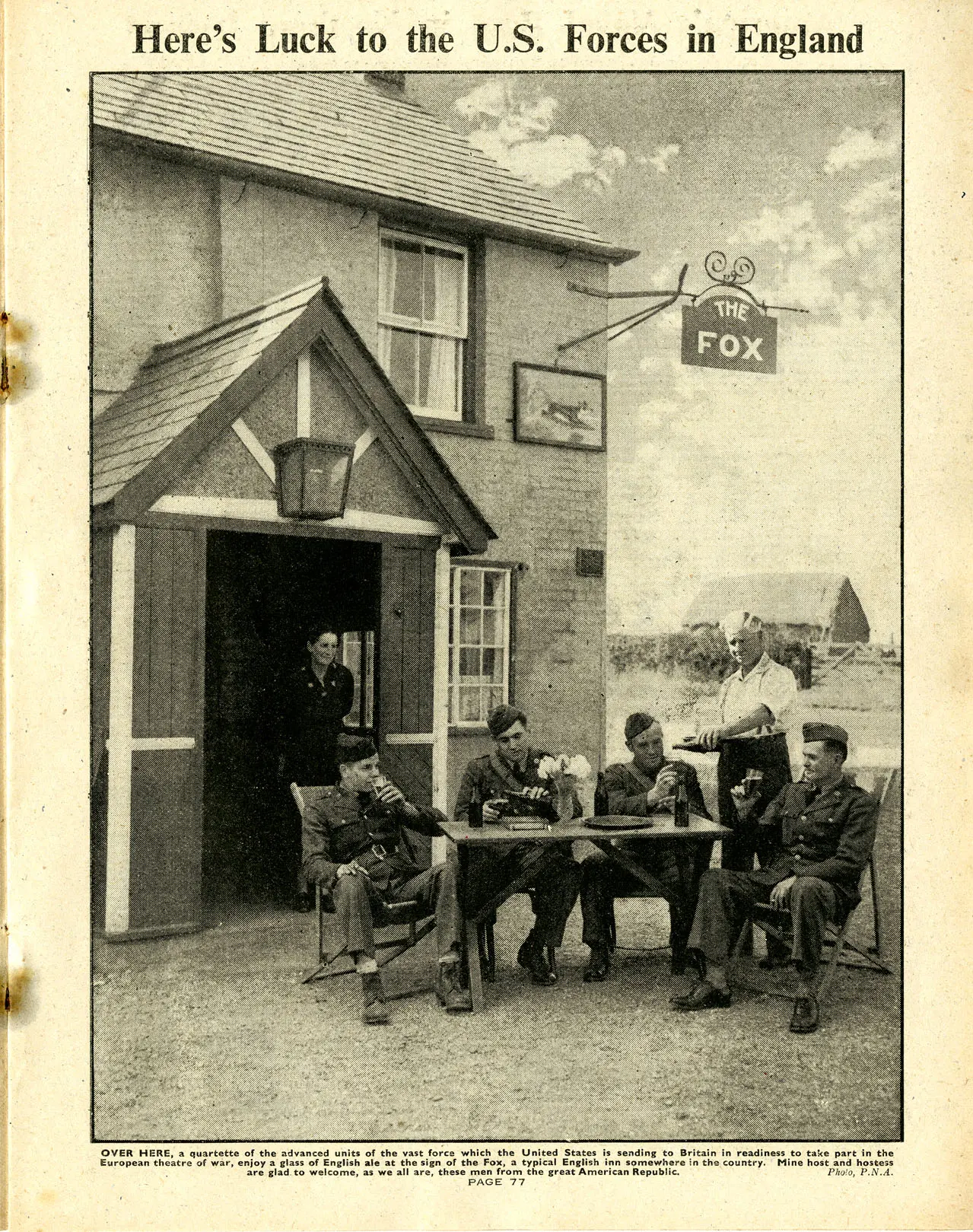
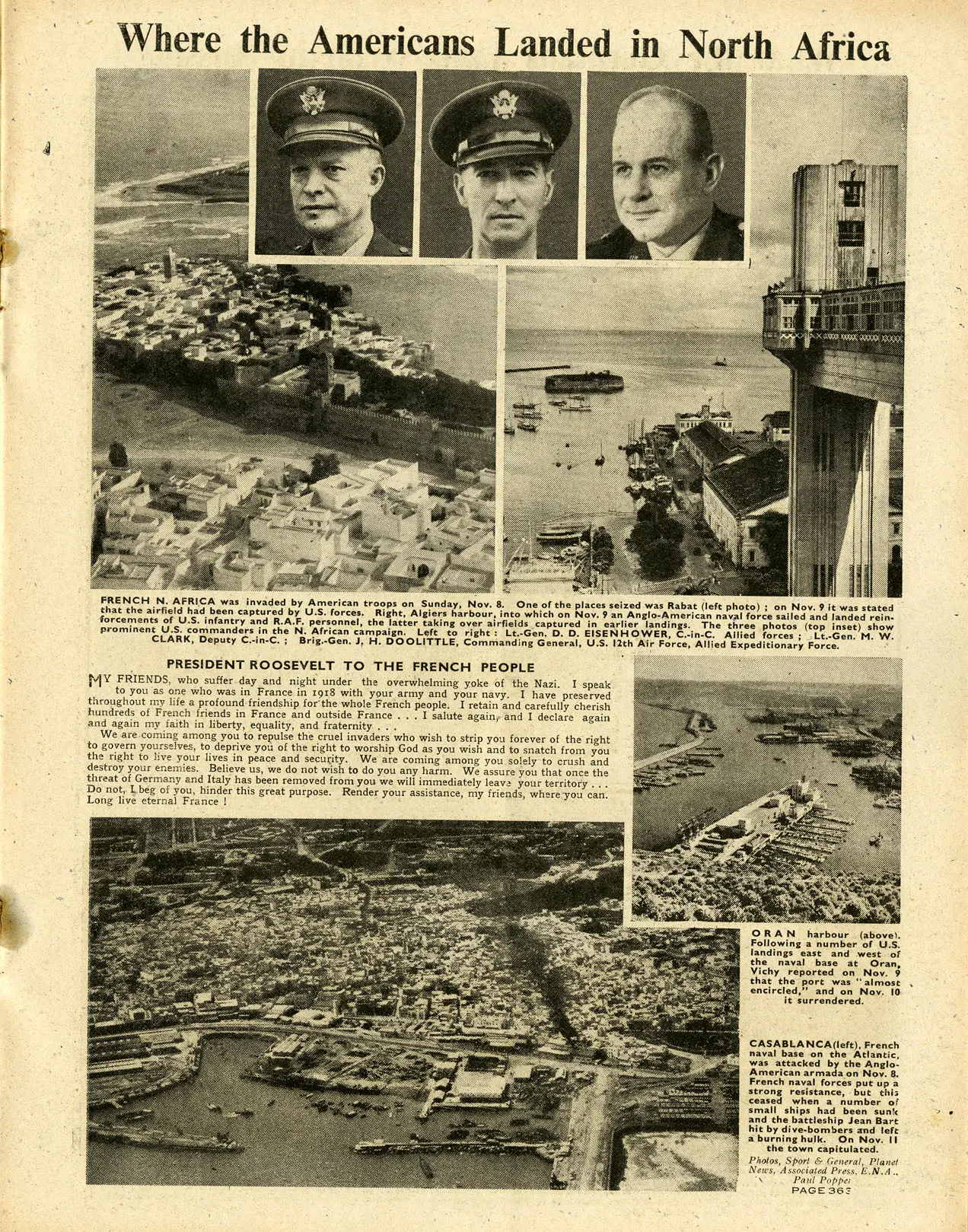
THE WAR ILLUSTRATED
Edited by Sir John Hammerton July 24, 1942
AMERICA IN N. IRELAND: a sentry on board a U.S. destroyer which has put in at the great American naval base that has been constructed at Londonderry, second city of Northern Ireland. A year ago Magee's Fields, as the site was named locally, was a stretch of tufted and boggy pastureland; now, where only sheep used to roam, American ships engaged in the Battle of the Atlantic are repaired and refitted. Even before the base was officially finished ships put in for overhaul, the first arrival being the U.S. converted fishing schooner Albatross, on January 17. The Commandant, Capt. Larson, says: "Give us any ship that's in trouble, and we'll see it home." Photo, Planet News
Citation:
Image reproduced courtesy of The University of Sheffield Library Special Collections.
Here's Luck to the U.S. Forces in England
OVER HERE, a quartette of the advanced units of the vast force which the United States is sending to Britain in readiness to take part in the European theatre of war, enjoy a glass of English ale at the sign of the Fox, a typical English inn somewhere in the country. Mine host and hostess are glad to welcome, as we all are, these men from the great American Republic.
Citation:
Image reproduced courtesy of The University of Sheffield Library Special Collections.
Where the Americans Landed in North Africa
[Top Caption]
FRENCH N. AFRICA was invaded by American troops on Sunday, Nov. 8. One of the places seized was Rabat (left photo) ; on Nov 9 it was stated that the airfield had been captured by U.S. forces. Right, Algiers harbour, into which on Nov. 9 an Anglo-American naval force sailed and landed reinforcements of U.S. infantry and R.A.F. personnel, the latter taking airfields captured in earlier landings. The three photos (top inset) show prominent U.S. commanders in the N. African campaign. Left to right : Lt-Gen. D. D. EISENHOWER, C.-in-C. Allied forces ; Lt-Gen. M. W. CLARK, Deputy C.-in-C. ; Brig-Gen. J. H. DOOLITTLE, Commanding General, U.S. 12th Air Force, Allied Expeditionary Force.
[Center Text]
PRESIDENT ROOSEVELT TO THE FRENCH PEOPLE
MY FRIENDS, who suffer day and night under the overwhelming yoke of the Nazi. I speak to you as one who was in France in 1918 with your army and your navy. I have preserved throughout my life a profound friendship for the whole French people. I retain and carefully cherish hundreds of French friends in France and outside France . . . I salute again, and I declare again and again my faith in liberty, equality, and fraternity . . .
We are coming among you to repulse the cruel invaders who wish to strip you forever of the right to govern yourselves, to deprive you of the right to worship God as you wish and to snatch from you the right to live your lives in peace and security. We are coming among you solely to crush and destroy your enemies. Believe us, we do not wish to do you any harm. We assure you that once the threat of Germany and Italy has been removed from you we will immediately leave your territory . . . Do not, I beg of you, hinder this great purpose. Render your assistance, my friends, where you can. Long live eternal France !
[Bottom Captions]
ORAN harbour (above). Following a number of U.S. landings east and west of the naval base at Oran, Vichy reported on Nov. 9 that the port was "almost encircled," and on Nov. 10 it surrendered.
CASABLANCA (left), French naval base on the Atlantic, was attacked by the Anglo-American armada on Nov. 8. French naval forces put up a strong resistance, but this ceased when a number of small ships had been sunk and the battleship Jean Bart hit by dive-bombers and left a burning hulk. On Nov. 11 the town capitulated.
Photos, Sport & General, Planet News, Associated Press, E.N.A.. Paul Poppe;
Citation:
Image reproduced courtesy of The University of Sheffield Library Special Collections.


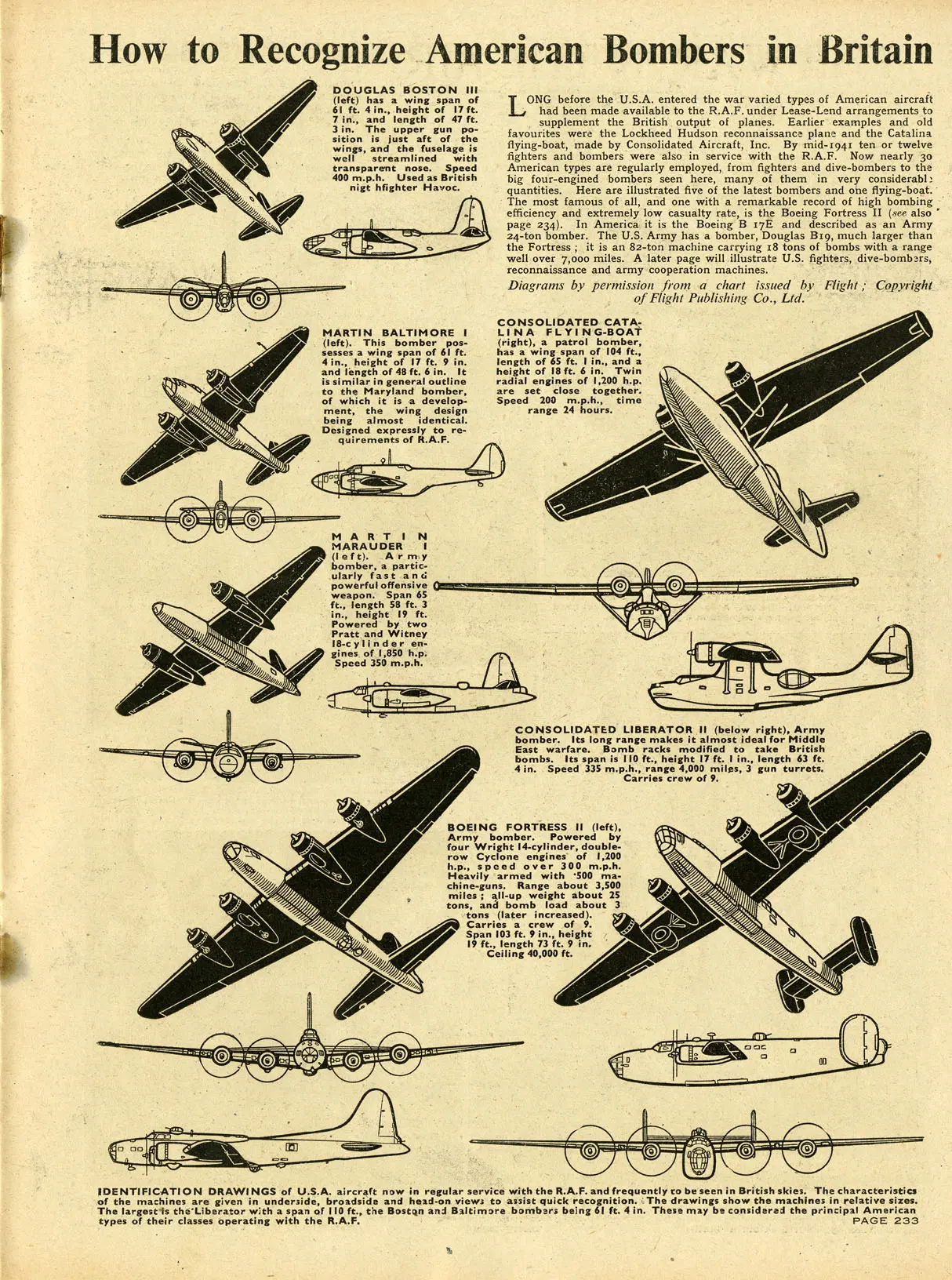
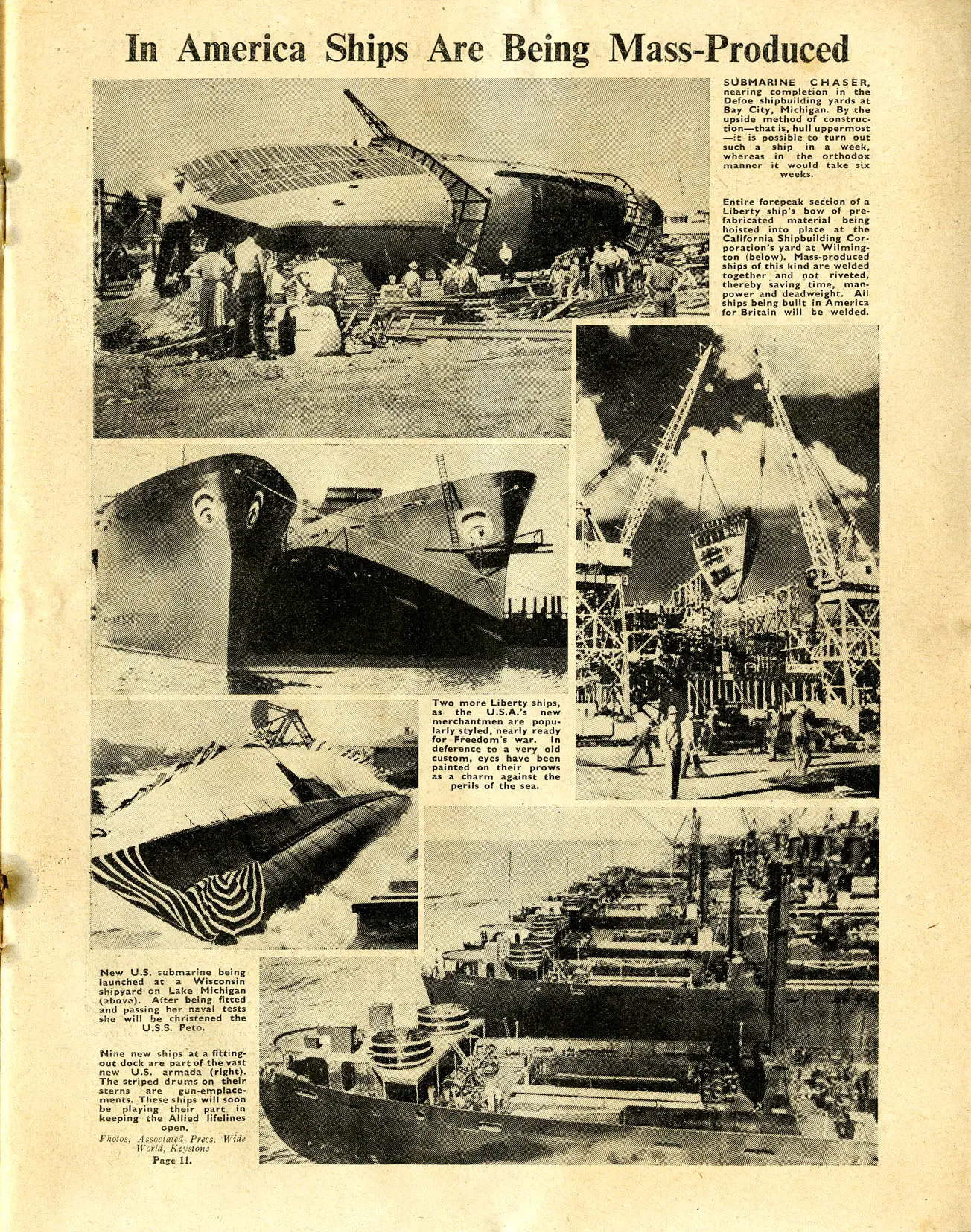
All Records Broken by America's Shipyards
A LIBERTY SHIP IN TEN DAYS! In one of the Pacific Coast shipyards of Mr. H. J. Kaiser, the world-famous American shipbuilder (see opposite page), workmen are engaged on the bottom of a Liberty ship (top). Five days later the freighter is well on the way to completion (centre right). Then, on Sept. 23 she takes to the water (bottom photo, radioed from America), 87 per cent complete. Three days later, 13 days 23 1/2 hours after her keel was laid, she was handed over to the U.S. Maritime Commission. Photos, Associated Press, Keystone
Citation:
Image reproduced courtesy of The University of Sheffield Library Special Collections.
How to Recognize American Bombers in Britain
[Top Right Text]
LONG before the U.S.A. entered the war varied types of American aircraft had been made available to the R.A.F. under Lease-Lend arrangements to supplement the British output of planes. Earlier examples and old favourites were the Lockheed Hudson reconnaissance plane and the Catalina flying-boat, made by Consolidated Aircraft, Inc. By mid-1941 ten or twelve fighters and bombers were also in service with the R.A.F. Now nearly 30 American types are regularly employed, from fighters and dive-bombers to the big four-engined bombers seen here, many of them in very considerable quantities. Here are illustrated five of the latest bombers and one flying-boat. The most famous of all, and one with a remarkable record of high bombing efficiency and extremely low casualty rate, is the Boeing Fortress II (see also page 234). In America it is the Boeing B 17E and described as an Army 24-ton bomber. The U.S. Army has a bomber, Douglas B19, much larger than the Fortress; it is an 82-ton machine carrying 18 tons of bombs with a range well over 7,000 miles. A later page will illustrate U.S. fighters, dive-bombers, reconnaissance and army cooperation machines.
Diagrams by permission from a chart issued by Flight ; Copyright of Flight Publishing Co., Ltd.
[Top Left Caption]
DOUGLAS BOSTON III (left) has a wing span of 61 ft. 4in., height of 17ft. 7in., and length of 47 ft. 3 in. The upper gun position is just aft of the wings, and the fuselage is well streamlined with transparent nose. Speed 400 m.p.h. Used as British nigt hfighter [sic] Havoc.
[Second Row Left Caption]
MARTIN BALTIMORE I (left). This bomber possesses a wing span of 61 ft. 4 in., height of 17 ft. 9 in. and length of 48 ft. 6in. It is similar in general outline to the Maryland bomber, of which it is a development, the wing design being almost identical. Designed expressly to requirements of R.A.F.
[Second Row Right Caption]
CONSOLIDATED CATALINA FLYING-BOAT (right), a patrol bomber, has a wing span of 104 ft., length of 65 ft. 1 in., and a height of 18 ft. 6 in. Twin radial engines of 1,200 h.p. are set close together. Speed 200 m.p.h., time range 24 hours.
[Third Row Left Caption]
MARTIN MARAUDER I (left). Army bomber, a particularly fast and powerful offensive weapon. Span 65 ft., length 58 ft. 3 in., height 19 ft. Powered by two Pratt and Witney 18-cylinder engines of 1,850 h.p. Speed 350 m.p.h.
[Third Row Right Caption]
CONSOLIDATED LIBERATOR II (below right), Army bomber. Its long range makes it almost ideal for Middle East warfare. Bomb racks modified to take British bombs. Its span is 110 ft., height 17 ft. 1 in., length 63 ft. 4in. Speed 335 m.p.h., range 4,000 miles, 3 gun turrets. Carries crew of 9.
[Fourth Row Center Caption]
BOEING FORTRESS II (left), Army bomber. Powered by four Wright 14-cylinder, double-row Cyclone engines of 1,200 h.p., speed over 300 m.p.h. Heavily armed with .500 machine-guns. Range about 3,500 miles ; all-up weight about 25 tons, and bomb load about 3 tons (later increased). Carries a crew of 9. Span 103 ft. 9in., height 19 ft., length 73 ft. 9in. Ceiling 40,000 ft.
[Bottom Caption]
IDENTIFICATION DRAWINGS of U.S.A. aircraft now in regular service with the R.A.F. and frequently to be seen in British skies. The characteristics of the machines are given in underside, broadside and head-on view; to assist quick recognition. The drawings show the machines in relative sizes. The largest is the Liberator with a span of 110 ft., the Boston and Baltimore bombers being 61 ft. 4in. These may be considered the principal American types of their classes operating with the R.A.F.
Citation:
Image reproduced courtesy of The University of Sheffield Library Special Collections.
In America Ships Are Being Mass-Produced
[Top Right Caption]
SUBMARINE CHASER, nearing completion in the Defoe shipbuilding yards at Bay City, Michigan. By the upside method of construction-that is, hull uppermost-it is possible to turn out such a ship in a week, whereas in the orthodox manner it would take six weeks.
Entire forepeak section of a Liberty ship's bow of prefabricated material being hoisted into place at the California Shipbuilding Corporation's yard at Wilmington (below). Mass-produced ships of this kind are welded together and not riveted, thereby saving time, manpower and deadweight. All ships being built in America for Britain will be welded.
[Center Caption]
Two more Liberty ships, as the U.S.A.'s new merchantmen are popularly styled, nearly ready for Freedom's war. In deference to a very old custom, eyes have been painted on their prows as a charm against the perils of the sea.
[Bottom Left Caption]
New U.S. submarine being laucnhed at a Wisconsin shipyard on Lake Michigan (above). After being fitted and passing her naval tests she will be christened the U.S.S. Peto.
Nine new ships at a fitting-out dock are part of the vast new U.S. armada (right). The striped drums on their sterns are gun-emplacements. These ships will soon be playing their part in keeping the allied lifelines open.
Citation:
Image reproduced courtesy of The University of Sheffield Library Special Collections.


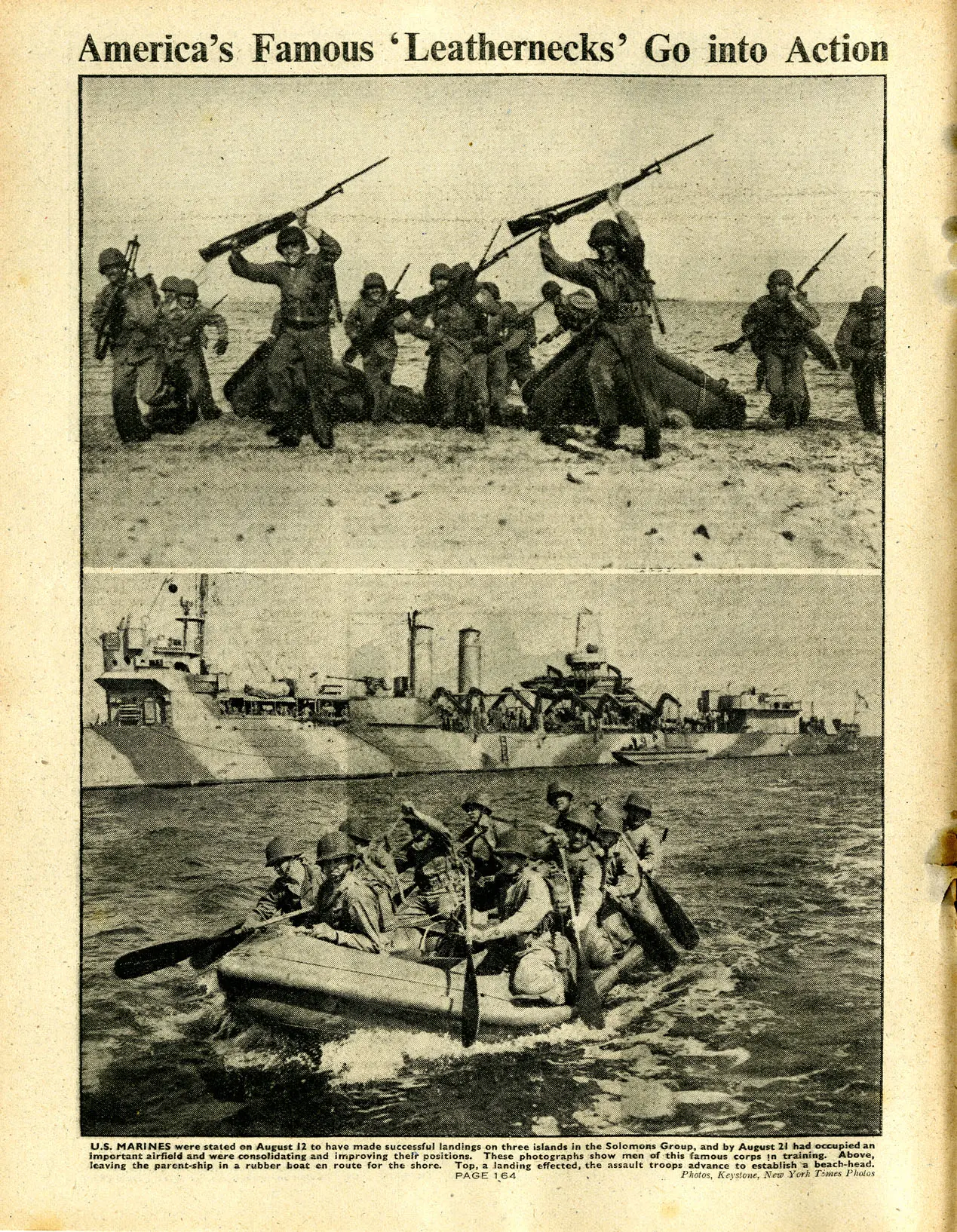
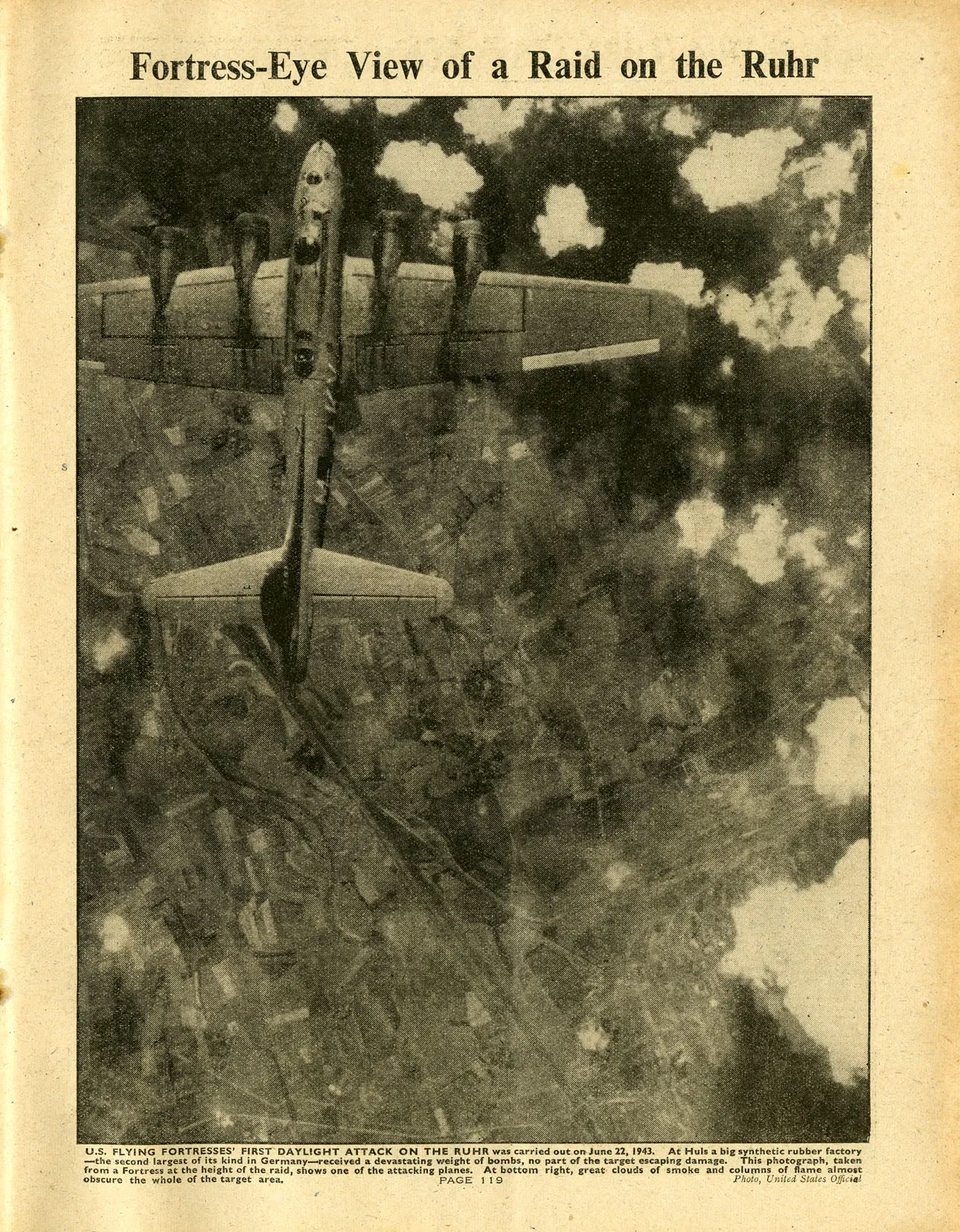
Flying Fortresses on an English Airfield
[Top Left Caption]
Two armament experts, one R.A.F. and the other American, overhauling the heavy calibre machine-guns in the base turret of a Flying Fortress. Below, a Fortress's tail, and (bottom right) air gunners engaged in a practice shoot.
[Top Right Caption]
American ground staff servicing a Flying Fortress. The U.S. Army Air Force in Britain is now so large that a special Service Command has been created to ensure a continuous flow of equipment to the aerodromes.
[Bottom Caption]
USED BY THE U.S. ARMY AIR FORCE on operations from R.A.F. bases, the Flying Fortresses are manned by American crews and serviced by American ground staff. These photographs were taken at a bomber station in England where hundreds of pilots, air-gunners, navigators and bomb-aimers receive their final training. Speed, high-flying, and their armament —they carry 12 machine-guns whose .5-inch ammo. has a longer range and greater hitting power than our .303-inch— make these giant planes most formidable opponents. Photos, Photopress, Planet News
Citation:
Image reproduced courtesy of The University of Sheffield Library Special Collections.
America's Famous 'Leathernecks' Go into Action
U.S. MARINES were stated on August 12 to have made successful landings on three islands in the Solomons Group, and by August 21 had occupied an important airfield and were consolidating and improving their positions. These photographs show men of this famous corps in training. Above, leaving the parent-ship in a rubber boat en route for the shore. Top, a landing effected, the assault troops advance to establish a beach-head. Photos, Keystone, New York Times Photos
Citation:
Image reproduced courtesy of The University of Sheffield Library Special Collections.
Fortress-Eye View of a Raid on the Ruhr
U.S. FLYING FORTRESSES' FIRST DAYLIGHT ATTACK ON THE RUHR was carried out on June 22, 1943. At Huls a big synthetic rubber factory—the second largest of its kind in Germany—received a devastating weight of bombs, no part of the target escaping damage. This photograph, taken from a Fortress at the height of the raid, shows one of the attacking planes. At bottom right, great clouds of smoke and columns of flame almost obscure the whole of the target area. Photo, United States Official
Citation:
Image reproduced courtesy of The University of Sheffield Library Special Collections.

Links With the Glorious Past
In a spirit of vindictive hostility for our legitimate attacks on Nazi war-centres, the Germans bombed and machine-gunned selected English cities from April 23 to 28. Here are some of the scenes of devastation following those raids. 1, A church at York. 2, All that was left of the Market Hall, Exeter. 3, The Boar's Head Inn, Norwich, which was built in 1495.
Broken by the Nazi Iconoclasts
Sacred buildings, colleges and fine old houses were like so much kindling to a diabolical holocaust. In spite of the heroic efforts of the fire brigades, many treasures were destroyed, though many more were saved. 4, Ruins of St. Luke's Diocesan Teachers' Training College, Exeter. 5, Firemen at work at Bath. 6, Damage close to Bath's famous Circus.
Citation:
Image reproduced courtesy of The University of Sheffield Library Special Collections.

Take-off at Dawn for the Day's Stern Task
Preliminaries completed, Fortresses await the arrival of trailers laden with one-ton bombs (1). With their loads aboard, one by one the great engines of destruction head down the runway (2) for take-off. Airborne (3), each takes up its appointed position in the formation, which is soon above the clouds (4) and headed for a German industrial centre-without an advance-guard of planes mounting anti-aircraft guns, as the Nazis fancifully declare !
Dead on the Target the Bombs Rain Down
Enemy planes sighted, a Fortress waist-gunner goes into action (5) and at least one would-be interferer is blasted out of the skies. Five miles above the target an oxygen-masked bombardier (7) calls over the intercom, " Bombs away ! " A glance downward, and he gives the American counterpart of the thumbs-up sign. Smoke and flames from the target—the 100-acres FW 190 factory at Marienburg, 200 miles beyond Berlin—soar high as the last Fortress turns for home (6).
Citation:
Image reproduced courtesy of The University of Sheffield Library Special Collections.